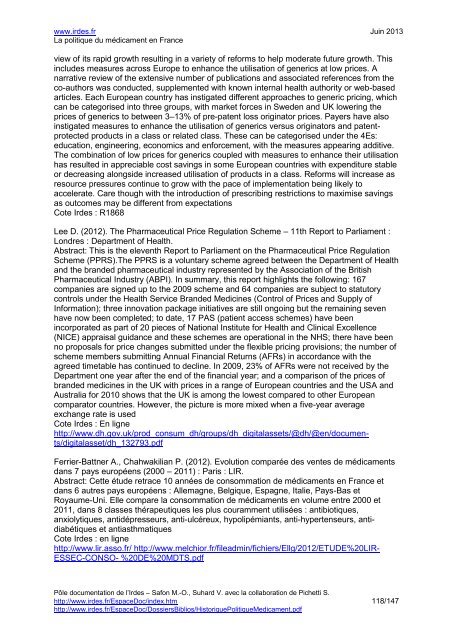HistoriquePolitiqueMedicament
HistoriquePolitiqueMedicament
HistoriquePolitiqueMedicament
You also want an ePaper? Increase the reach of your titles
YUMPU automatically turns print PDFs into web optimized ePapers that Google loves.
www.irdes.fr Juin 2013<br />
La politique du médicament en France<br />
view of its rapid growth resulting in a variety of reforms to help moderate future growth. This<br />
includes measures across Europe to enhance the utilisation of generics at low prices. A<br />
narrative review of the extensive number of publications and associated references from the<br />
co-authors was conducted, supplemented with known internal health authority or web-based<br />
articles. Each European country has instigated different approaches to generic pricing, which<br />
can be categorised into three groups, with market forces in Sweden and UK lowering the<br />
prices of generics to between 3–13% of pre-patent loss originator prices. Payers have also<br />
instigated measures to enhance the utilisation of generics versus originators and patentprotected<br />
products in a class or related class. These can be categorised under the 4Es:<br />
education, engineering, economics and enforcement, with the measures appearing additive.<br />
The combination of low prices for generics coupled with measures to enhance their utilisation<br />
has resulted in appreciable cost savings in some European countries with expenditure stable<br />
or decreasing alongside increased utilisation of products in a class. Reforms will increase as<br />
resource pressures continue to grow with the pace of implementation being likely to<br />
accelerate. Care though with the introduction of prescribing restrictions to maximise savings<br />
as outcomes may be different from expectations<br />
Cote Irdes : R1868<br />
Lee D. (2012). The Pharmaceutical Price Regulation Scheme – 11th Report to Parliament :<br />
Londres : Department of Health.<br />
Abstract: This is the eleventh Report to Parliament on the Pharmaceutical Price Regulation<br />
Scheme (PPRS).The PPRS is a voluntary scheme agreed between the Department of Health<br />
and the branded pharmaceutical industry represented by the Association of the British<br />
Pharmaceutical Industry (ABPI). In summary, this report highlights the following: 167<br />
companies are signed up to the 2009 scheme and 64 companies are subject to statutory<br />
controls under the Health Service Branded Medicines (Control of Prices and Supply of<br />
Information); three innovation package initiatives are still ongoing but the remaining seven<br />
have now been completed; to date, 17 PAS (patient access schemes) have been<br />
incorporated as part of 20 pieces of National Institute for Health and Clinical Excellence<br />
(NICE) appraisal guidance and these schemes are operational in the NHS; there have been<br />
no proposals for price changes submitted under the flexible pricing provisions; the number of<br />
scheme members submitting Annual Financial Returns (AFRs) in accordance with the<br />
agreed timetable has continued to decline. In 2009, 23% of AFRs were not received by the<br />
Department one year after the end of the financial year; and a comparison of the prices of<br />
branded medicines in the UK with prices in a range of European countries and the USA and<br />
Australia for 2010 shows that the UK is among the lowest compared to other European<br />
comparator countries. However, the picture is more mixed when a five-year average<br />
exchange rate is used<br />
Cote Irdes : En ligne<br />
http://www.dh.gov.uk/prod_consum_dh/groups/dh_digitalassets/@dh/@en/documen-<br />
ts/digitalasset/dh_132793.pdf<br />
Ferrier-Battner A., Chahwakilian P. (2012). Evolution comparée des ventes de médicaments<br />
dans 7 pays européens (2000 – 2011) : Paris : LIR.<br />
Abstract: Cette étude retrace 10 années de consommation de médicaments en France et<br />
dans 6 autres pays européens : Allemagne, Belgique, Espagne, Italie, Pays-Bas et<br />
Royaume-Uni. Elle compare la consommation de médicaments en volume entre 2000 et<br />
2011, dans 8 classes thérapeutiques les plus couramment utilisées : antibiotiques,<br />
anxiolytiques, antidépresseurs, anti-ulcéreux, hypolipémiants, anti-hypertenseurs, antidiabétiques<br />
et antiasthmatiques<br />
Cote Irdes : en ligne<br />
http://www.lir.asso.fr/ http://www.melchior.fr/fileadmin/fichiers/Ellg/2012/ETUDE%20LIR-<br />
ESSEC-CONSO- %20DE%20MDTS.pdf<br />
Pôle documentation de l’Irdes – Safon M.-O., Suhard V. avec la collaboration de Pichetti S.<br />
http://www.irdes.fr/EspaceDoc/index.htm 118/147<br />
http://www.irdes.fr/EspaceDoc/DossiersBiblios/<strong>HistoriquePolitiqueMedicament</strong>.pdf


